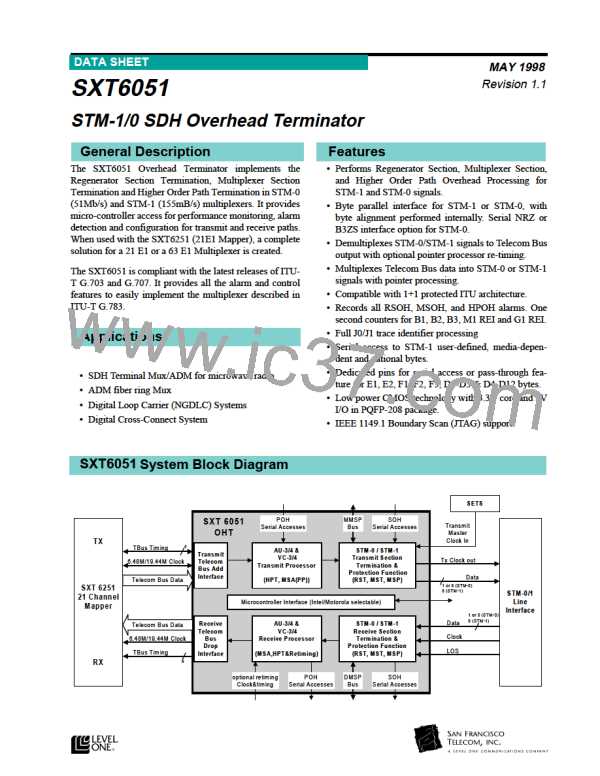SXT6051 STM-1/0 SDH Overhead Terminator
Frame Acquisition Algorithm
Loss of Frame (LOF) Detection
The frame acquisition algorithm is done on byte-wide
key word identification. The framer eliminates the
eight phases (bits) of ambiguity and memorizes the
position of the frame word. The framer also identifies
the position of the new data flag (NDF).
Upon detection of an Out Of Frame condition, no con-
secutive action is required by the ITU specifications.
The number of Out of Frame events are counted and
stored in a 13-bit counter accessible via registers 43H
and 44H.
Two consecutive frames with correct frame words and
identical NDF are required to change from an Out Of
Frame State (OOF) to an In Frame State (INF). To
declare an OOF condition, four consecutive frames
with incorrect frame words are required.
The Loss Of Frame state machine can be configured
via the registers 41H and 42H. Three parameters are
programmable (from 1 to 32 frames) in the state
machine:
M is the number of consecutive frames with no Out Of
Frame conditions required to re-enter a normal state. N
is the number of consecutive frames with no Out Of
Frame conditions required to re-enter a normal state
from a Loss Of Frame state. L is the number of non-
consecutive frames with Out Of Frame conditions
required to enter a Loss Of Frame state.
For certain values of the HPOH pointer, “R” bits in the
VC12 container in STM-0 will look like a framing
word after scrambling. This results in false frame syn-
chronization. To eliminate this problem, the acquisi-
tion machine is configurable (see register 40H).
The robust configuration requires five consecutive
frames with identical NDF and two consecutive
frames with the correct frame word for frame acquisi-
tion. This will minimize the probability of incorrect
synchronization. To ensure that an OOF condition is
activated when an incorrect synchronization occurs,
the state machine will desynchronize when eight con-
secutive frames not having identical NDF bits.
Status changes in the OOF & LOF detectors generate
OOF & LOF alarms. Also, output from these detectors
is provided at the OOF & LOF output pins.
Regenerator Section Receiver
This section provides access to all Regenerator Section
Overhead Bytes. All the overhead bytes (27 in STM-1
and 9 in STM-0) are accessible at the RSOH serial out-
put.
Upon frame acquisition, the framer de-scrambles the
signal. The standard scrambler defined by the ITU is
(27–1). Two additional scramblers (211-1) and (213-1)
can be programmed for STM-0 and STM-1 (see regis-
ter 50H). This flexibility allows the optimum choice of
scrambler for a radio application where an equal distri-
bution of 1s and 0s is required.
Figure 10:Overhead Bytes for the STM-1
A1
B1
D1
A1
A1
A2
E1
D2
A2
A2
J0
F1
D3
RSOH
Figure 9:LOF State Machine
AU Pointers
K1
OofSt
= 0
B2
D4
B2
B2
K2
D6
D5
D8
N O R M
D7
D9
MSOH
N
OofSt
=
1
consecutive
frames with
OofSt = 0
D10
S1
D11
D12
E2
M
M1
consecutive
frames with
OofSt = 0
Reserved for National Use
L
Media dependant Byte
Undefined Bytes
non-consecutive
frames with
OofSt = 1
LOF
S T W
OofSt
= 1
29

 LevelOne [ LEVEL ONE ]
LevelOne [ LEVEL ONE ]